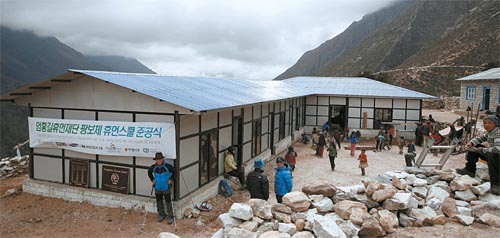Vertical limit tragedy becomes loving tribute

The Pangboche Human School, built by the Um Hong-gil Human Foundation, is a tribute by the famed Korean mountaineer to a Sherpa guide, Sulin Dorugi, who died helping him climb Mount Everest in 1986. Provided by the foundation
In January 1986, Um Hong-gil, 27, was making his second attempt to conquer Mount Everest, a feat never accomplished by a Korean. He paused at a camp 900 meters from the summit to wait for Sulin Dorugi, his 20-year-old Sherpa, or Nepali guide, to reach him with food supplies and climbing equipment. Dorugi, Um believed, was around 600 meters behind him.
In fact, Dorugi had fallen and no one knew what happened to him. Um abandoned his attempt at the summit, and the Korean record, to double back to find him. He never did: Dorugi’s remains were never found.
“Dorugi was like my little brother,” Um said. “I returned to Pangboche [his village] after I lost him and I cried helplessly in front of his mother and his wife because I felt guilty.” The guilt was particularly strong because Dorugi was a newlywed: He had married his 18-year old bride only three months earlier. The marriage was too brief for Durugi’s wife to conceive a child.
Today, on Children’s Day, Um will fulfill his decades-old promise to build a school in Dorugi’s tiny Nepalese village 3,950 meters (12,959 feet) above sea level on the foot of the 8,848-meter Mount Everest. For many mountaineers, Pangboche is the gateway to Everest and its summit.
“Dorugi’s little sisters are married and they have kids,” said Um, 50, who became the first Korean to scale Everest two years after Dorugi’s death. “I wanted to build an elementary school where his nephews and nieces can study.”
The Pangboche Human School, opening today after construction over the last 12 months by the Um Hong-gil Human Foundation, consists of four classrooms, a library, restrooms, a clinic and an auditorium. More than 70 children can study and play at the facility. Um’s foundation plans to recruit two teachers and one nurse and pay their salaries, instead of getting funds from the Nepalese government.
After scaling Everest in 1988, Um became the first person in the world to climb the 16 highest mountains on earth, according to EverestHistory.com.
“Building a school in a region that’s located at the edge of the Himalayas was a great labor,” he said, “almost as hard as climbing a Himalayan mountain.”
Um’s foundation mobilized helicopters to drop construction materials to a downhill village 3,500 meters above sea level. Yaks hauled the materials to Pangboche. The school cost over $150,000, much higher than what the foundation estimated.
Last month, Um’s foundation had a groundbreaking for its second school in Tharpu village, 32 kilometers (19 miles) away from Nepal’s capital of Katmandu. The Tharpu elementary school will have 11 classrooms, an auditorium and kindergarten.
“I’m giving schools as a gift because I don’t want young Nepalese students to pass on their poverty to their children,” Um said. “That’s what happened with Dorugi, who grew up in a very poor educational environment.”
By Kim Mi-ju, Park Tae-hee [mijukim@joongang.co.kr]










with the Korea JoongAng Daily
To write comments, please log in to one of the accounts.
Standards Board Policy (0/250자)